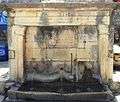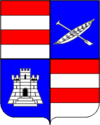Ston
| Ston | |
|---|---|
 Ston | |
| Coordinates: 42°50′N 17°42′E / 42.833°N 17.700°ECoordinates: 42°50′N 17°42′E / 42.833°N 17.700°E | |
| Country |
|
| County |
|
| Government | |
| • Mayor | Vedran Antunica |
| Elevation | 0 m (0 ft) |
| Population (2011)[1] | |
| • Total | 2,407 |
| Time zone | UTC+1 (CET) |
| • Summer (DST) | UTC+2 (CEST) |
| Postal code | 20 230 |
| Area code(s) | +385 20 |
| Vehicle registration | DU |
| Website |
www |
Ston (pronounced [stɔ̂n]; Italian: Stagno) is a city and municipality in the Dubrovnik-Neretva County of Croatia, located at the south of isthmus of the Pelješac peninsula. The town of Ston is the center of the Ston municipality.
History

Because of its geopolitical, strategic and traffic position, Ston has been studying a rich history from antiquity. Located on the gates of the peninsula, surrounded by three seas, protected by four hills, rich in water, saltwater, fertile plains, was an important political, cultural and ecclesiastical center. Ston is the first bishopric in the Croatian ethnic space. It is possible that the bishop in Ston already at the end of the 7th or early eighth century.
Formerly the Illyrian settlements of the Romans in 167 BC make their own colony. Croats embarked at the time of Heracles in the early 7th century, and united in the faith with the Romans. Christianity is developing in Roman form.
At the Saloon 533 congregation, a diocese was established in Sarsenterum for the Zahumlja or Humske area, which belongs to the church in Ston (Pardui). A little then Sarsenterum is destroyed, most likely at the time of Avara's destruction. As Ston was not on Avara's ruinous visit, he was still spared. Therefore it becomes the seat of the principals of the Thanksgiving. And as the secular and ecclesial powers go together, it is assumed that Ston, after the disappearance of Sarsenterum, also became the ecclesiastical center. The diocese is mentioned for the first time in 877 but as a diocese of the old age, and the bishop is a suffragan of the Split metropolis. By setting up a metropolis in Dubrovnik, Ston is a sufragan of Dubrovnik.
Upon the arrival of the Croats, the area of the Neretva, across the northern Herzegovina mountain to Transylvania in Rijeka, Dubrovačka, forms the prince of Zahumlje. The same, along the Neretva, Primorje and Herzegovina, also belong to Ston with Rat (Peljesac) and Mljet. There are rulers in the country who acknowledge the supremacy of Byzantium. Behind the well-known Mihajlo Višević, who once admitted the power of Bulgarian Simeon, Zahumlje ruled for a shorter or longer period of different dynasties. So around 950. I was briefly summoned by Duke Časlav. At the end of the 10th century Lord Zahumlja was Samuilo, and the duked king Ivan Vladimir. In 1168 the Dukesian kingdom and Zahumlje were conquered by Raški major prefect of Stevan Nemanja. Thirty years later, Zahumlje invades Andrija, Duke of Croatia and Dalmatia. Bela IV. he conquered Bosnia and Zahumlje in 1254, and from 1304 in Zahumlje was Mladen Šubić, then again for short Serb parishioners, and 1325 Stjepan Kotromanić and finally Dubrovnik.
The old Ston was located on the slopes of the hills south of the Ston field, on Gorica and on the head of St. Michael. There were more early Christian churches, the largest of which was St. Stephen's Church. Mary Magdalene, a bishopric church, stood by the bombing of the "allies" in 1944 The only church that is still standing on the head is the church of St. Mihajla, built in the middle of the late antique castrum. The old town was demolished in the 1252 earthquake, and with the arrival of the Republic, a new city is being built in today's location. When some of the interventions at the church of St. Michael at the top of the hill were made, fragments of Roman decorative plastics, parts of Roman tombstones and parts of antique ceramics were found confirming this assumption. According to some sources Ston experienced heavy days of civil war in 1250, and in these conflicts the city suffered a great deal of destruction and destruction.
The disquiet at the beginning of XIV. century, occupied the entire country of zahuma, the usurpation of the brothers Branivojević, forced the people of Dubrovnik to fight with Branivojevic, and with the help of Bosnian ban Stjepan Kotromanović in 1326 . That year, Dubrovnik occupied Ston. The Dubrovnik people immediately begin to think to build and establish a new Ston, to defend Peljesac and protect the slaves from which they have earned big revenue. Since the conflict between Bosnian Ban and Serbo-Croatian Pelješac with Ston came under the rule of the Serbian king, the Dubrovniks purchased from this landmark of 1333 the rule of both rulers. The first cathedral church was that of St. Mary Magdalene on Gorica, and from the 10th century Church of Our Lady of Lužina. After the adherence to Ston Dubrovačka Republika, at the site of today's damaged parish church was built, at the decision of the Senate 1342. cathedral church of St. Blaise. From then on to the fall of the Dubrovnik Republic Ston is an integral part and its second city of importance. In 1333, Dubrovnik started with the planned construction of the town of Ston and Little Ston and the fortress at the present site. Under the hill Podzvizd are located Veliki Ston and Mali Ston on the other small sea. The length of the entire cladding between the two towns is made of large walls that were supposed to defend the Dubrovnik estate - Peljesac. This whole fortification complex - unique to both Europe and us - has been created in quite a short time.
The disappearance of the Republic of Dubrovnik, by the sudden and often incomprehensible operations of the 19th century. such as the demolition of the city walls in Mali ston because of the suppression of malaria, the demolition of the city's masonry in Velika Stona due to the arrival of Austrian emperor Franjo Josip in an official visit, the monumental stonemic fortification complex suddenly collapses, his moth becomes a quarry for nearby new outcrops, foundations. Only since 1945 the restoration of the stone monuments, the reconstruction of the fortifications and the tower, has been renewed since 1945 and were again damaged in the Homeland War (1991-1992), with a devastating earthquake in 1996. Recently, thanks to the Society of Friends of the Dubrovnik Walls, it is slowly but surely reconstructed the stone forts and towers, so that the monumental stonewall complex now begins to live again in its old dignity.
Cultural monuments
Walls of Ston
After the Republic of Dubrovnik acquired the Peljesac in 1334, it required the protection of Ston. First, in thirty years, a wall defensive (one of the longest in Europe) has been erected on one side of the peninsula, and according to a unique project, two established towns have been planned: southern Ston and northern Mali Ston with the aim of gathering people to preserve the boundaries and work in solanas the state has much gained. Between 1461 and 1464, at the stonemasons, the Florentine architect Michelozzo commissioned the order of the Dubrovnik republic. For the Great Wall (1200 m long) on Podzvizd, for protection from neighbors, the chronicles state that its construction lasted for 18 months and stood at 12,000 ducats .
Ston Fortress without any doubt is one of the largest construction projects of the time, whose original length is 7000 m, consists of the walls of Ston and Little Ston, the Great Wall with these three fortresses, while the walls and fortresses are flanked with 10 rounds and 31 square squares and 6 semi-circular bastions. The complex defense corps has been shaped for almost four centuries, due to the adaptation of the field and the development of weapons.
The walls were of great importance because they were defending the saltworks that donated 15,900 ducats every year to the Dubrovnik Republic, the shellfish farm and the city itself.
In 1667, about 0.5 km of walls were destroyed in a catastrophic earthquake, and the walls were significantly damaged in the earthquakes in 1979 and 1996.
In 2004, work on the restoration and restoration of obsolete walls was started, with the aim of facilitating visits to the area between Veliki and Mali Ston. It was assumed that the works would be completed by May 2008, but only the original part of the Ston Bridge was rebuilt. The reconstruction of the Great Wall in Ston, worth about five million kuna, was completed, and it was announced that the stone walls with public entrance fee will be opened in May 2009. Part of the wall is open to the public with a ticket fee at the beginning of October 2009. To date (state of 14 June 2013) along the original part of the city, the road has been restored to the small Ston. To go to the first part takes 15 min, and to get from the Great to the Small Wall to the walls 30 min. Today the majority has been restored.
See also
Gallery
 Street in Ston, Croatia
Street in Ston, Croatia City Centre in Ston, Croatia
City Centre in Ston, Croatia Street in Ston
Street in Ston Entrance to Ston City Walls in Croatia
Entrance to Ston City Walls in Croatia Church of St. Blaise
Church of St. Blaise View from the Fort of Kaštio
View from the Fort of Kaštio
References
- ↑ "Population by Age and Sex, by Settlements, 2011 Census: Ston". Census of Population, Households and Dwellings 2011. Zagreb: Croatian Bureau of Statistics. December 2012.
Sources
- Ćosić, Stjepan. “The Nobility of the Episcopal Town of Ston (Nobilitas civitatis episcopalis Stagnensis) Dubrovnik Annals, Vol. No. 5, 2001.
- Gudelj, Krešimira. “Coastal toponymy of the Ston region,” Folia onomastica Croatica, Vol. No. 20, 2011Melita Peharda, Mirjana Hrs-Brenko, Danijela Bogner, “Diversity of bivalve species in Mali Ston Bay, Adriatic Sea," Acta Adriatica, Vol. 45 No. 2, 2004.
- Lupis, Vinicije B. , “Mediaeval crucifixes from Ston and its surrounding area,” Starohrvatska prosvjeta, Vol. III No. 38, 2011.
- Miović, Vesna. "Emin (Customs Officer) as Representative of the Ottoman Empire in the Republic of Dubrovnik," Dubrovnik Annals 7 (2003): pp. 81–88.
- Tomšić, Sanja, and Josip Lovrić. “Historical overview of oyster culture in Mali Ston Bay,” Naše more, Znanstveno-stručni časopis za more i pomorstvo, Vol. 51 No. 1-2, 2004.
- Andrej Žmegač. “The Ston Fortification Complex - Several Issues,” Prilozi povijesti umjetnosti u Dalmaciji, Vol. 39 No. 1, 2005
- Nikodim, Bishop of Dalmatia and Istria (1914). Ston u srednjim vijekovima. Nakl. piščeva.
External links
| Wikimedia Commons has media related to Ston. |
